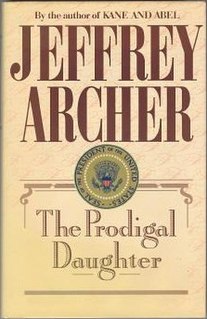
Jack Leon Ruby was an American nightclub owner who murdered Lee Harvey Oswald when he fatally shot him on November 24, 1963, while Oswald was in police custody after being charged with both the murder of John F. Kennedy, the incumbent United States president, and the murder of Dallas policeman J. D. Tippit. A Dallas jury found Ruby guilty of murdering Oswald and sentenced him to death. Previously before his conviction for killing Oswald, Ruby was involved in criminal activity, as well as linked to organized crime.

Jeffrey Howard Archer, Baron Archer of Weston-super-Mare is an English novelist, life peer, convicted criminal, and former politician. Before becoming an author, Archer was a Member of Parliament (1969–1974), but did not seek re-election after a financial scandal that left him almost bankrupt.

Jacqueline Lee Kennedy Onassis was an American socialite, writer, photographer, and book editor who served as first lady of the United States from 1961 to 1963, as the wife of President John F. Kennedy. A popular first lady, she endeared the American public with her fashion sense, devotion to her family, and dedication to the historic preservation of the White House. During her lifetime, she was regarded as an international fashion icon.

Everette Howard Hunt Jr. was an American intelligence officer and author. From 1949 to 1970, Hunt served as an officer in the Central Intelligence Agency (CIA), particularly in the United States involvement in regime change in Latin America including the 1954 Guatemalan coup d'état and the 1961 Bay of Pigs invasion. Along with G. Gordon Liddy, Frank Sturgis, and others, Hunt was one of the Nixon administration "plumbers", a team of operatives charged with identifying government sources of national security information "leaks" to outside parties. Hunt and Liddy plotted the Watergate burglaries and other clandestine operations for the Nixon administration. In the ensuing Watergate scandal, Hunt was convicted of burglary, conspiracy, and wiretapping, eventually serving 33 months in prison. After release, Hunt lived in Mexico and then Florida until his death.

Libra is a 1988 novel by Don DeLillo that describes the life of Lee Harvey Oswald and his participation in a fictional CIA conspiracy to assassinate President John F. Kennedy. The novel blends historical fact with fictional supposition.

The Prodigal Daughter is a novel by Jeffrey Archer, published in 1982. It is the story of Florentyna Rosnovski, the daughter of Abel Rosnovski of Archer's Kane and Abel. The novel, one of Archer's best sellers, portrays Florentyna's life from early childhood to her final ascension to the position of President of United States. In this way, President Kane becomes the first female U.S. president.

Kane and Abel is a 1979 novel by British author Jeffrey Archer.
The New York City landmark bomb plot was a plan to follow up the February 1993 World Trade Center bombing and was designed to inflict mass casualties on American soil by attacking well-known landmark targets throughout New York City, United States. If the attack had been successful, thousands likely would have died.

On March 1, 1967, New Orleans District Attorney Jim Garrison arrested and charged New Orleans businessman Clay Shaw with conspiring to assassinate President Kennedy, with the help of Lee Harvey Oswald, David Ferrie, and others. On January 29, 1969, Shaw was brought to trial in Orleans Parish Criminal Court on these charges. On March 1, 1969, a jury took less than an hour to find Shaw not guilty. It remains the only trial to be brought for the assassination of President Kennedy.

Coronet Books was established in 1966 as the paperback imprint of Hodder & Stoughton. The imprint was closed in 2004 but then relaunched in 2010, publishing fiction and non-fiction in hardback and paperback, including works by Chris Ryan, Lorna Byrne, and Auberon Waugh.
The John F. Kennedy assassination and the subsequent conspiracy theories surrounding it have been discussed, referenced, or recreated in popular culture numerous times.
A major American icon, Jacqueline Kennedy Onassis has been portrayed, alluded to, and referred to in many media in the popular culture from the 1960s and continuing into the 21st century.
The CIA Kennedy assassination theory is a prominent John F. Kennedy assassination conspiracy theory. According to ABC News, the Central Intelligence Agency (CIA) is represented in nearly every theory that involves American conspirators. The secretive nature of the CIA, and the conjecture surrounding high-profile political assassinations in the United States during the 1960s, has made the CIA a plausible suspect for some who believe in a conspiracy. Conspiracy theorists have ascribed various motives for CIA involvement in the assassination of President Kennedy, including Kennedy's firing of CIA director Allen Dulles, Kennedy's refusal to provide air support to the Bay of Pigs invasion, Kennedy's plan to cut the agency's budget by 20 percent, and the belief that the president was weak on communism.
Thomas Henry Guinzburg was an American editor and publisher who served as the first managing editor of The Paris Review following its inception in 1953 and later succeeded his father as president of the Viking Press.

The assassination of John F. Kennedy on November 22, 1963, and the murder of Lee Harvey Oswald by nightclub owner Jack Ruby spawned numerous conspiracy theories. These theories allege the involvement of the CIA, the Mafia, Vice President Lyndon B. Johnson, Cuban Prime Minister Fidel Castro, the KGB, or some combination of these entities. The original FBI investigation and Warren Commission report, as well as an alleged "benign CIA cover-up", have led to the claim that the federal government deliberately covered up crucial information in the aftermath of the assassination. Former Los Angeles District Attorney Vincent Bugliosi estimated that a total of 42 groups, 82 assassins, and 214 people had been accused at one time or another in various conspiracy scenarios.










